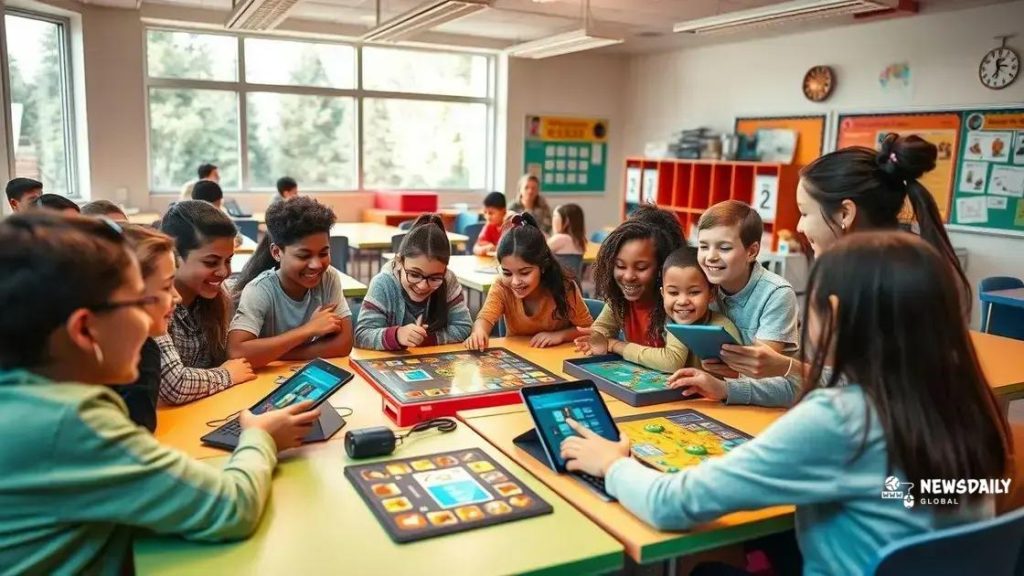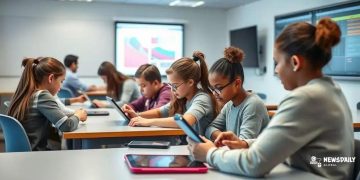The role of gamification in enhancing student engagement

The role of gamification in enhancing student engagement involves using game elements to create interactive and enjoyable learning experiences, which can improve motivation, retention, and collaboration among students.
The role of gamification in enhancing student engagement is gaining traction among educators looking to motivate learners. Have you noticed how games can make learning more enjoyable? In this article, we’ll dive into the significance of gamification and its impact on students.
Understanding gamification and its principles
Understanding gamification is essential for educators looking to enhance student engagement in classrooms. By incorporating game elements into learning, teachers can create an inviting and exciting atmosphere. This approach helps capture students’ attention and encourages them to actively participate in their education.
What is Gamification?
Gamification involves using game design principles in non-game contexts. In education, this means applying game-like features to lessons to motivate students. Instead of traditional teaching methods, gamification transforms learning into an enjoyable experience. It can make challenging subjects more accessible and relatable.
Key Principles of Gamification
Successful gamification relies on several key principles:
- Motivation: Engaging students by providing rewards for accomplishments.
- Feedback: Offering immediate feedback helps students understand their progress.
- Progression: Allowing learners to see their advancement keeps them eager to continue.
- Competition: Healthy competition can drive students to perform better.
These principles not only motivate students but also encourage them to engage with the material actively. By incorporating elements such as points, badges, and leaderboards, educators can create an interactive and stimulating environment.
A well-implemented gamification strategy can lead to improved retention of information. When students are actively involved in learning, they are more likely to remember what they’ve learned. Furthermore, gamification allows for personalized learning experiences. This means students can progress at their own pace, making education more tailored to individual needs.
Exploring different gamification tools is crucial. There are many platforms available that help educators apply gamification in the classroom. Some popular options include Kahoot!, Classcraft, and Quizizz. Each of these tools offers unique features designed to enhance student engagement.
Benefits of gamification for student engagement
Benefits of gamification for student engagement are vast and impactful. By incorporating game elements, teachers can make learning more enticing for students. This approach creates a positive and interactive environment that keeps students interested in their education.
Increased Motivation
One of the primary benefits of gamification is that it significantly boosts motivation. Students are more eager to participate in activities when they can earn points or rewards. When lessons feel like games, students are driven to perform better.
Improved Retention of Information
Gamification also enhances information retention. When students engage with material through games, they’re more likely to remember what they’ve learned. This connection between play and learning solidifies their understanding.
Encouragement of Collaboration
Another advantage is that it fosters collaboration among students. Many gamified activities require teamwork, which builds social skills and community within the classroom. Students learn to work together toward common goals.
- Competitive Spirit: Friendly competition inspires students to push their limits and do their best.
- Instant Feedback: Gamification provides immediate feedback, allowing students to correct mistakes and improve quickly.
- Customizable Learning: Gamified tools often allow for adjustments based on student preferences, enhancing personal relevance.
Furthermore, gamification can cater to different learning styles. Some students may thrive in a competitive environment, while others may prefer cooperative tasks. This flexibility allows educators to reach a wider range of learners.
Another benefit is the reduction of anxiety. Since gamified activities are often seen as fun rather than serious tests, students may feel less pressure. This relaxed atmosphere can lead to greater participation and less fear of making mistakes.
In addition, students develop essential skills such as problem-solving and critical thinking through gamified learning. These skills are invaluable for academic success and future careers, making gamification an effective educational strategy.
Examples of gamification in education

Examples of gamification in education provide a clear picture of how this approach can enhance learning experiences. Many educators are now using game-like techniques to engage students and make lessons more interactive.
Classroom Games
One popular example is turning lessons into classroom games. Teachers might create quizzes that reward points for correct answers. This encourages active participation. Students feel more motivated to learn when competition is involved.
Digital Platforms
Several digital platforms also incorporate gamification elements. For instance, Kahoot! allows educators to create fun quizzes where students compete in real time. With game-like features such as leaderboards, students are excited to participate.
Badges and Rewards
Implementing badge systems is another effective method. Students earn badges for completing tasks or achieving goals. This visual representation of their achievements fosters a sense of accomplishment.
- Classcraft: A role-playing game that allows students to take on character roles and complete quests tied to academic content.
- Quizizz: A learning tool where students answer questions at their own pace, earning points and rewards for their efforts.
- Flipgrid: A video discussion platform where students earn rewards for participating in discussions and sharing videos.
Through gamified activities, educators can also create scavenger hunts for research projects. This involves students working together to find information in a fun and dynamic way.
Additionally, game-based learning simulations can teach complex subjects. For physics or chemistry, simulations can show how concepts apply in real-world scenarios, making learning experiences more relatable.
Using gamification strategies not only increases engagement but also enhances the overall learning process. When students have fun while learning, they are more likely to absorb and retain information effectively.
Challenges in implementing gamification
Challenges in implementing gamification can arise for educators wanting to enhance engagement through game-like techniques. While the benefits are significant, several obstacles can make it difficult to effectively apply these methods in the classroom.
Resistance to Change
One major challenge is the resistance to change from both teachers and students. Some educators may prefer traditional teaching methods over new approaches. Students might also be hesitant about new activities, especially if they are used to a structured learning environment.
Resource Limitations
Another challenge is limited resources. Schools may lack access to technology or tools that facilitate gamification. This can hinder teachers’ ability to implement engaging activities that utilize video games or online platforms.
Training and Support
Inadequate training for educators can also be a barrier. Without proper guidance, teachers may struggle to effectively design gamified lessons. Providing adequate professional development ensures that all educators can confidently create engaging experiences.
- Time Constraints: Teachers often have limited time to prepare and plan gamified lessons.
- Curriculum Alignment: Integrating game elements within existing curricula can be complex.
- Assessment Methods: Traditional evaluation methods may not work well with gamified learning.
Moreover, measuring the success of gamification initiatives can be challenging. Educators need to find effective ways to assess students’ progress and engagement. This can lead to confusion and frustration for teachers who aim to provide meaningful feedback.
Despite these challenges, many educators are finding innovative ways to overcome them. By starting small and gradually incorporating gamified elements, teachers can build their confidence. Collaboration among educators can also lead to successful implementation as they share best practices and resources.
Lastly, it’s important to emphasize the necessity for student input in the gamification process. Educators should listen to students’ preferences and adapt their strategies accordingly. This not only helps in creating an engaging atmosphere but also fosters a sense of ownership among students.
Measuring the impact of gamification on learning
Measuring the impact of gamification on learning is crucial to understand its effectiveness in the classroom. Educators need concrete data to evaluate how gamified elements influence student engagement and academic performance.
Using Assessments
One key method for measuring impact is through assessments. Teachers can compare test scores and assignments before and after implementing gamification. This allows for a clear understanding of any improvements in retention and comprehension.
Analyzing Engagement Metrics
Another important aspect is analyzing engagement metrics. Platforms used for gamified learning often provide data on student participation, such as time spent on tasks and completion rates. By monitoring these metrics, teachers can identify whether students are more engaged when gamified elements are included.
- Participation Rates: Increases in participation rates can indicate higher student interest.
- Completion Rates: Tracking how many students finish tasks can show the effectiveness of gamification.
- Feedback Surveys: Collecting feedback from students provides insights into their experiences and perceptions.
Additionally, teachers can use feedback surveys to gather qualitative data. By asking students about their feelings towards gamified activities, educators can gauge overall satisfaction and motivation. This feedback is invaluable for adjusting teaching methods and improving gamification strategies.
Pre- and post-tests can also help in assessing knowledge retention. By administering tests before gamification is introduced and after its implementation, teachers can see if there is a noticeable increase in scores. This method provides concrete evidence of the effectiveness of gamified learning.
Furthermore, it’s essential to consider the long-term impact of gamification. Tracking students over time can reveal whether enhanced engagement leads to sustained academic performance. Continual monitoring helps educators refine their approaches to ensure lasting benefits.
In summary, a combination of quantitative and qualitative measures is needed for a comprehensive evaluation of gamification in education. By using various assessment methods, teachers can better understand how gamified elements influence learning outcomes.
FAQ – Frequently Asked Questions about Gamification in Education
What is gamification and how does it work in education?
Gamification involves using game elements in non-game contexts, such as classrooms, to make learning more engaging and fun for students.
How can gamification improve student engagement?
Gamification increases motivation by allowing students to earn rewards, compete with peers, and see their progress, making them more involved in their learning.
What are some challenges of implementing gamification in the classroom?
Challenges include resistance to change, lack of resources, and insufficient training for teachers, which can hinder effective implementation.
How can teachers measure the impact of gamification on learning outcomes?
Teachers can use assessments, analyze engagement metrics, and gather feedback from students to evaluate the effectiveness of gamified activities.






